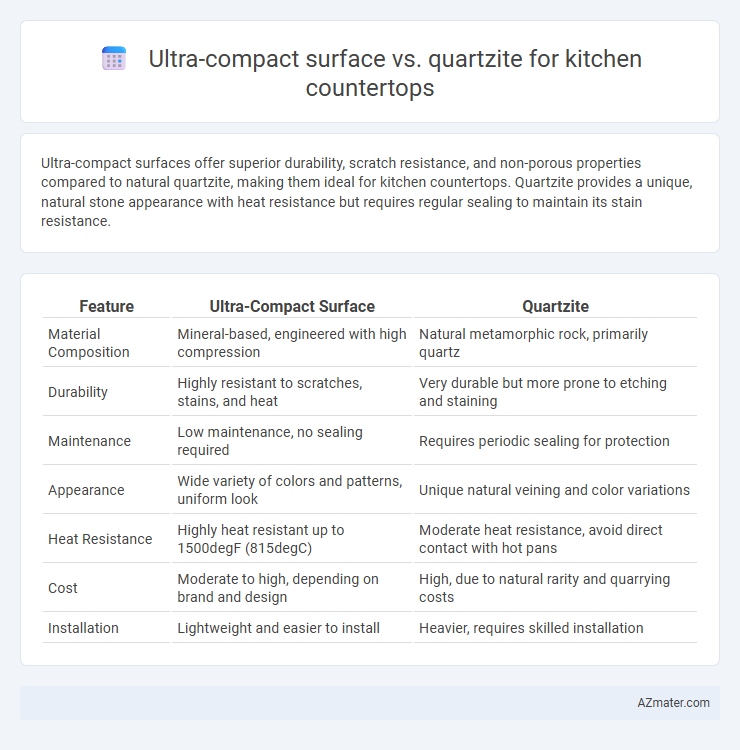Ultra-compact surfaces offer superior durability, scratch resistance, and non-porous properties compared to natural quartzite, making them ideal for kitchen countertops. Quartzite provides a unique, natural stone appearance with heat resistance but requires regular sealing to maintain its stain resistance.
Table of Comparison
| Feature | Ultra-Compact Surface | Quartzite |
|---|---|---|
| Material Composition | Mineral-based, engineered with high compression | Natural metamorphic rock, primarily quartz |
| Durability | Highly resistant to scratches, stains, and heat | Very durable but more prone to etching and staining |
| Maintenance | Low maintenance, no sealing required | Requires periodic sealing for protection |
| Appearance | Wide variety of colors and patterns, uniform look | Unique natural veining and color variations |
| Heat Resistance | Highly heat resistant up to 1500degF (815degC) | Moderate heat resistance, avoid direct contact with hot pans |
| Cost | Moderate to high, depending on brand and design | High, due to natural rarity and quarrying costs |
| Installation | Lightweight and easier to install | Heavier, requires skilled installation |
Understanding Ultra-Compact Surfaces: What Are They?
Ultra-compact surfaces are engineered stone materials composed of a blend of natural minerals, including quartz and porcelain, fused at high temperatures to achieve exceptional density and durability. These surfaces offer superior resistance to heat, scratches, and stains compared to traditional quartzite countertops, making them ideal for high-traffic kitchen environments. Ultra-compact materials provide a non-porous, low-maintenance alternative that combines aesthetic versatility with long-lasting structural integrity.
Quartzite Countertops: Natural Beauty and Strength
Quartzite countertops offer unparalleled natural beauty with unique veining and a glossy finish that adds elegance to any kitchen. Renowned for their extreme durability, quartzite surfaces resist heat, scratches, and etching, making them ideal for high-traffic kitchen environments. Unlike ultra-compact surfaces, quartzite is a natural stone that combines aesthetic appeal with lasting strength, ensuring both functional performance and timeless style.
Appearance and Aesthetic Comparison
Ultra-compact surfaces offer a sleek, uniform appearance with a wide range of vibrant colors and finishes that mimic natural stone or concrete, making them highly versatile for modern kitchen designs. Quartzite, a natural stone, provides unique, intricate veining and a luxurious, organic aesthetic that varies with each slab, enhancing the kitchen's elegance and exclusivity. Both materials exhibit a polished, high-end look, but ultra-compact surfaces deliver consistency and customization, while quartzite emphasizes natural beauty and individual character.
Durability: Scratch, Heat, and Stain Resistance
Ultra-compact surfaces exhibit superior durability compared to quartzite, offering exceptional scratch, heat, and stain resistance due to their dense, non-porous composition. Quartzite, while naturally hard and heat-resistant, is more prone to etching and staining without proper sealing and maintenance. For kitchen countertops demanding low maintenance and high resilience, ultra-compact materials deliver prolonged performance against daily wear and tear.
Maintenance Requirements: Ultra-Compact vs Quartzite
Ultra-compact surfaces require minimal maintenance, being highly resistant to stains, scratches, and heat, and only need regular cleaning with mild soap and water. Quartzite countertops, while durable, demand periodic sealing to prevent staining and etching from acidic substances, as well as cautious cleaning to avoid damage. These differences make ultra-compact materials a low-maintenance alternative compared to the more upkeep-intensive care needed for quartzite.
Environmental Impact and Sustainability
Ultra-compact surfaces, made from a blend of natural minerals and resin, offer high durability and low porosity, reducing the need for harsh chemical cleaners and extending lifespan, which helps lower environmental impact. Quartzite, a natural stone quarried from the earth, requires intensive extraction processes that can lead to habitat disruption and higher carbon emissions but is celebrated for its long-lasting qualities and natural composition. Choosing between the two depends on prioritizing manufacturing emissions versus natural resource preservation, with ultra-compact surfaces often having a smaller carbon footprint and quartzite offering a fully natural material option.
Installation Process and Challenges
Ultra-compact surfaces, composed of dense materials like porcelain, are lightweight and flexible, allowing for easier handling and installation compared to heavy and brittle quartzite slabs. The installation of quartzite requires specialized tools and skilled labor due to its hardness and fragility, increasing the risk of cracking and chipping during cutting and fitting. Ultra-compact materials offer quicker installation times and fewer complications, making them a more efficient choice for kitchen countertops in terms of labor and handling challenges.
Cost Analysis: Initial Investment and Longevity
Ultra-compact surfaces generally require a higher initial investment than quartzite, starting around $50 to $120 per square foot compared to quartzite's $40 to $100 due to premium manufacturing processes and advanced durability features. Quartzite offers excellent longevity with natural resistance to heat and scratches, often lasting decades when properly sealed, while ultra-compact surfaces provide superior stain resistance and minimal maintenance, contributing to lower lifecycle costs. Over time, quartzite may incur additional sealing and care expenses, whereas ultra-compact surfaces maintain their appearance without frequent treatments, balancing upfront costs with reduced long-term maintenance.
Popular Brands and Color Options
Ultra-compact surfaces like Dekton and Neolith offer superior durability and a wide range of colors from sleek blacks to vibrant reds, appealing to modern kitchen designs. Quartzite, sourced from natural stone, is favored by brands such as Marble Systems and MSI, providing unique veining patterns in neutral tones like whites, grays, and beiges. Both materials present diverse aesthetic options, but ultra-compact surfaces provide more consistent color choices with enhanced resistance to scratches and heat.
Choosing the Right Material: Factors to Consider for Your Kitchen
Ultra-compact surfaces offer superior resistance to heat, scratches, and stains compared to quartzite, making them ideal for high-traffic kitchens demanding durability and low maintenance. Quartzite provides a natural stone aesthetic with unique veining and color variations but requires regular sealing to prevent damage from acidic substances. When choosing the right material for your kitchen countertop, assess factors like durability, maintenance needs, design preferences, and budget to ensure optimal functionality and style.

Infographic: Ultra-compact surface vs Quartzite for Kitchen Countertop
 azmater.com
azmater.com